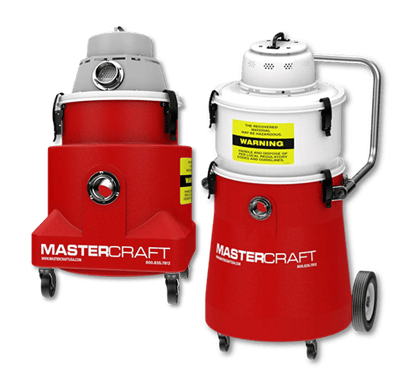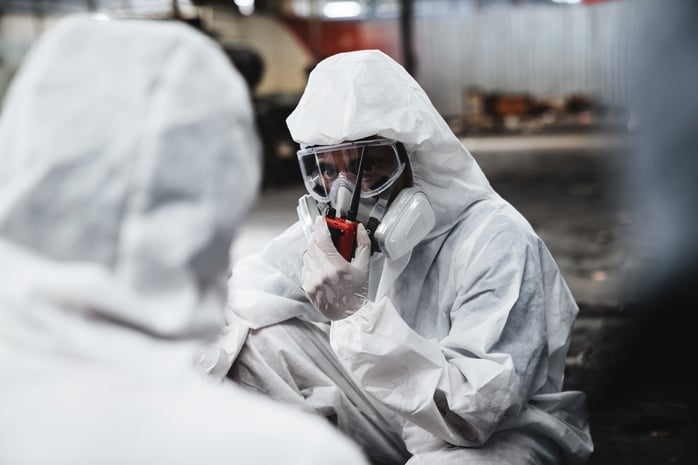Lead and asbestos are two of the most hazardous substances that are present in many older buildings and homes. Because both of these materials can be potentially dangerous, proper handling of toxic substances is essential to ensure the occupational safety and health of yourself and your workers.
By investing in quality lead and asbestos removal equipment, you’ll be able to minimize risk when dealing with these materials. Below, we’ve outlined some of the best equipment to use for lead and asbestos removal.
The Dangers of Lead
Due to its use as a common building material in the past, lead is often found in older buildings and homes. In fact, lead was used widely throughout the 20th century, so it’s not uncommon to find it in many older buildings, schools, and homes.
When lead is ingested or inhaled it can cause serious health problems such as cancer, neurological damage, and even death.
Spotting Lead
Lead can often be spotted by its color and texture. It’s usually associated with a dull, chalky gray color and has a crumbly or powdery texture. Lead is often found in old paint, plumbing pipes, and around window frames.
It’s important to be able to spot lead so that you can properly handle it. There are a few ways that you can detect lead:
- Visual Inspection: Inspecting the appearance of an area is often the first step when it comes to identifying potential sources of lead exposure. Lead can often be spotted by its color and texture.
- Lead Testing Kits: Lead testing kits are available for purchase and can help you detect lead with greater accuracy. These kits include swabs that can be used to collect samples from suspected areas, which will then need to be sent off for further analysis in a lab.
- Professional Inspectors: Some local governments may require a trained professional to inspect for lead. Professional inspectors can accurately identify and test for lead, as well as provide you with a clear plan of action on how to deal with the materials in question.

The Dangers of Asbestos
Asbestos is a group of naturally occurring minerals that are resistant to heat, fire, and electricity. Because of their durability, they were once widely used in consumer products, from oven mitts to building insulation. However, in the 1970s, it was discovered that asbestos exposure can cause serious cancers and other diseases such as mesothelioma and asbestosis.
The real issues with asbestos start when it is disturbed. This means that if, for example, you are breaking down a wall that has tiny asbestos fibers still in it - these tiny fibers then start flying into the air and expose those around it to hazardous air pollutants.
What Are Other Side Effects of Asbestos Exposure?
Asbestos fibers can cause various other health issues, such as lung scarring, respiratory problems like asthma and COPD, and even pleural effusions (which is a fluid build-up in the lungs).
Who is Most Susceptible to Asbestos Exposure?
The people most at risk of asbestos exposure is anyone who is working in a construction environment or otherwise handling any asbestos material. Asbestos fibers can also be found in older commercial buildings too, so if you own an old building and are undertaking any renovation work, it’s important to have the area tested for asbestos.
Spotting Asbestos
There won’t be any visible or odorous asbestos in an asbestos-filled building. In the case of asbestos-containing materials (ACMs), if the deadly tiny asbestos fibers are released, that dust will smell like any other dust. This is why asbestos surveys and air monitoring are extremely important.
Types of Asbestos
If you spot any asbestos, you can expect to find three variations: blue, brown, and white. Residential and commercial properties may contain crocidolite (blue), amosite (brown), and chrysotile (white) asbestos.
Known as the most hazardous of all asbestos types, crocidolite asbestos was used as insulation for steam engines and for spray-on coatings, pipe insulation, plastics, and cement. The fibers are ultrathin and blue.
The second most commonly used asbestos in the U.S. is amosite, which causes more cancer than other types. This type of asbestos was frequently used in cement sheets and pipe insulation, as well as insulation boards floor tiles, ceiling tiles, and thermal insulation products.
The most common asbestos is chrysotile. This form of asbestos was commonly used for linings in brake systems, gaskets and seals in boilers, and insulation in pipes, ducts, and appliances. Chrysotile is white in color and has layered structures and curly fibers.
Overview of Lead and Asbestos Removal Process
The removal process for lead and asbestos (also known as asbestos abatement) is a complex one often requiring specialized tools and equipment. This is because lead or asbestos must be safely removed from the area and disposed of properly in an approved facility.
Typically, lead removal and asbestos abatement projects will involve:
- Testing to confirm the presence of lead or asbestos
- Creating a containment zone (sealing off the area)
- Employing a specialist for the removal of lead or asbestos
- Smudging, scraping, or wetting the material to minimize dust
- Vacuuming, air purifying, and other cleaning measures after removal is complete
- Proper disposal of any removed materials

Types of Equipment Used in Lead and Asbestos Removal
vacuum cleaners
Vacuum cleaners are essential for any lead or asbestos dust removal project. They’re used to suck up and contain dust particles that may contain lead or asbestos fibers, preventing them from becoming airborne and causing health hazards. Vacuums come in a variety of sizes and designs depending on the type of environment they’ll be used in.
A regular vacuum cleaner can spread dust and other particles, so it’s important to use one with a HEPA filter instead. HEPA filters trap the smallest particles of lead and asbestos, minimizing the risk of spreading them further into the environment.
Protective Clothing
It’s important for anyone working on a lead or asbestos removal project to wear protective clothing. This includes long-sleeved shirts, pants, gloves, eye protection, and boots. This will help minimize contact with hazardous materials and keep workers safe.
Air Purifiers
Air purifiers are used to help reduce airborne dust particles during a lead or asbestos removal project. The filters in these purifiers trap and remove hazardous particles, ensuring that the air is safe to breathe.
Disposal Bins
Disposal bins are also important for lead and asbestos removal projects. These secure containers can be used to safely store any hazardous material until it can be properly disposed of.
Testing Equipment
Testing equipment is essential for detecting lead or asbestos materials in buildings or other areas that are under renovation. These tools are used to identify any potential lead or asbestos hazards before a project begins. This helps ensure that the area is safe and free from contamination.

Considerations When Choosing Equipment
Cost of Equipment
When it comes to purchasing lead and asbestos removal equipment, cost is always a factor. Some of the more specialized pieces of equipment can be expensive, so it’s important to make sure that you’re getting the best value for your money.
Safety Considerations
Safety should always be a top priority when dealing with hazardous materials like asbestos and lead, and asbestos. Make sure that any equipment you purchase is rated for use in hazardous environments and will provide the necessary protection to keep workers safe.
Quality of Equipment
It’s important to make sure that any equipment used in lead or asbestos removal is of high quality. Low-quality tools can be unreliable and potentially dangerous, so make sure that you invest in trusty equipment.
Brand Reputation
It’s also important to research the brand of any equipment that you’re considering purchasing. Make sure to read reviews and do your research to make sure that you’re buying from a reputable company with good customer service.

Safety Tips
When dealing with lead and asbestos removal, safety is of the utmost importance. It’s essential to take all necessary precautions to minimize potential health risks.
Here are some tips for staying safe while working on a lead or asbestos removal project:
- Wear protective clothing and equipment at all times.
- Follow proper containment protocols when beginning a project.
- Vacuum and air purify regularly to minimize dust particles.
- Ensure that all lead or asbestos materials are properly disposed of in an approved facility.
- Monitor workers for signs of illness or contamination.
- Consistently maintain and upkeep vacuums to ensure they are always working at their best capacity.
Conclusion
Lead and asbestos removal is a complex and risky process, but with proper preparation, it can be done safely. Making sure that you’re using the right lead and asbestos removal equipment for your project is essential. It can help ensure a safe environment, maximize efficiency, and minimize potential health hazard risks.
With careful research and purchasing of quality equipment, as well as following proper occupational safety and federal regulations and procedures, lead and asbestos removal can be completed without incident.
Looking for quality equipment to get the job done? Look no further than Mastercraft!
0 comments